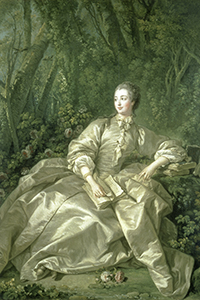

Victoria & Albert Museum
Photo Courtesy of Victoria & Albert Museum London
The new Europe 1600-1815 Galleries at London’s Victoria & Albert Museum introduce visitors to a relatively little known period of the continent’s history. The galleries’ lead curator Lesley Miller takes us on a walk-through past priceless paintings, sculptures, domestic items, fashion, prints, textiles and more, all the while giving us the lowdown on how this stunning exhibit came to be.
The galleries opened this past fall. Tell us about the process of creating them.
You see it coming along very very gradually and then, suddenly, everything changes because the lighting designers come in and the atmosphere changes. We started back in 2009 with some ideas on the back of a postcard for the senior management group and they gave us certain parameters to work in: chronological organization, thematic displays. We were told 1,000 objects but you can tell, looking at the size of the objects, that that doesn’t mean a lot.
What informed your choices of what to display?
We formed a concept team: an educator and two curators. And then, it grew to five curators. For 18 months, we had brainstorming sessions with all of the experts on the 17th and 18th century in the museum and round tables with people outside the museum. You get your curatorial colleagues to identify must-have objects. Then we thought in terms of themes. You pin ideas up on the wall with objects and then things get discarded because we don’t have the objects to do it because everything has to be a V&A object.

Madame de Pompadour by Francois Boucher, Photo Courtesy of Victoria & Albert Museum London
Can you give us an example?
I had a very keen colleague who wanted a display on Madame de Pompadour. When you you went into the catalog, there were lots of things associated with Madame de Pompadour but when you came down to it, there are only something like three or four that were really associated with her, one being a painting, and that’s not quite big enough for a whole display.
So, then you have to think, where are you going to put Madame de Pompadour? The painting is an A-list object. What Madame de Pompadour now does is look towards the enlightenment. This is the Rococo display so it’s about patronage of the arts. She was a supporter of Diderot when he was writing the encyclopedia, so the idea is that she is both serious and involved with the arts.
Tell us about returning the gallery spaces themselves to how they would have been when the Victoria and Albert Museum was built in 1857.
In the 1970s, they brought the ceilings down and blocked out the windows, partly because they were putting in air conditioning and partly because, at that time, ideas about how you can manage light in these environments was probably not as advanced as today.
The first thing we had to do was take out that build – that’s why the architects were charged with making sure that you could see all the way down the galleries with the original architecture. We wanted a different atmosphere for each style that you get.
What were the practical considerations of designing the space and the exhibits within it?
On the pacing side — avoiding museum fatigue — we saw very clearly that, given you’ve got seven galleries, four long interspersed with three small, that the three small ones could work as a different type of experience. Seating was very important. The idea is that there are places to sit but that the experience you have in the small galleries is a more immersive experience while the long galleries are more traditional museum displays.
Tell us about the challenges of curating for the long term.
We’re thinking of a life span of about 25 years for these galleries. It doesn’t mean everything will stay exactly the same — partly because the light sensitive material will have to be rotated — but it does mean that this is the built format. You’re playing with objects, with stories, with space. If it’s going to be chronological, how are you going to divide up the chronology?

Inside The Gallery, Photo Courtesy of David Grandorge and Victoria and Albert Museum London
What do you want visitors to take away from their visit?
We do not assume art historical knowledge when you come into these galleries, which is quite different from past generations. In the past you would have assumed that people coming to the V&A would know about the Bible, about classical myths and legends, religion, basic art historical labels like Baroque, Rococo, etc.
We don’t assume that anymore. Our main role is to engage people so they want to learn more. It’s about stimulating interest. We’re aiming for a curious, interested audience, not for an audience that necessarily has knowledge.
How do you go about doing that?
It’s trying to attract people with something they’re familiar with. You’ll find far more images of people than there were before because we know from the great success of the Fashion Galleries, for example, which are probably one of the most successful galleries in the museum, that people respond very well to the human figure and they will go and look at a portrait or a mannequin.
Aside from the V&A, what are your favorite galleries around the world?
The Musée de la Chasse et de la Nature in Paris. We found it very inspiring on a number of levels when we were preparing the Europe Galleries. As a textile and dress specialist, I love the Musée de la Toile de Jouy in Jouy-en-Josas, between Paris and Versailles. I much appreciate many large national museums such as the Rijksmuseum in Amsterdam. But these personal suggestions are somewhat smaller and less well known.
